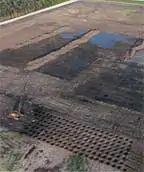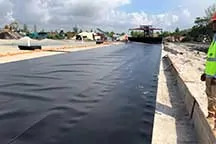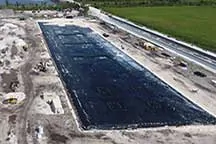

SCS Engineers is hosting our 2023 Solid Waste Seminars on March 10 in Roanoke, Virginia, and on March 17 in Richmond, Virginia. Registrants have the option of attending the Richmond seminar virtually ($100).
This half-day seminar is designed to provide updates on the latest regulatory, policy, and technological developments in the solid waste, landfill, landfill gas, and sustainable materials management industries. The sessions are presented by experienced SCS professionals, and continuing education units are available.
This year, our professionals will cover these important topics:
Lunch will be provided.
The seminar is intended for solid waste management professionals, landfill managers, waste/recycling managers, supervisors, and operators. For attendees already possessing solid waste management and disposal experience, topics will provide a fresh perspective and cover important regulatory and technological updates. For those new to the field, topics will cover essential information on various critical aspects of waste/ recycling program collections, transfer, processing, and disposal, as well as landfill development, operations, monitoring, and management
We look forward to seeing you there!
SCS Engineers is hosting our 2023 Solid Waste Seminars on March 10 in Roanoke, Virginia, and on March 17 in Richmond, Virginia. Registrants have the option of attending the Richmond seminar virtually ($100).
This half-day seminar is designed to provide updates on the latest regulatory, policy, and technological developments in the solid waste, landfill, landfill gas, and sustainable materials management industries. The sessions are presented by experienced SCS professionals, and continuing education units are available.
This year, our professionals will cover these important topics:
Lunch will be provided for in-person attendees.
The seminar is intended for solid waste management professionals, landfill managers, waste/recycling managers, supervisors, and operators. For attendees already possessing solid waste management and disposal experience, topics will provide a fresh perspective and cover important regulatory and technological updates. For those new to the field, topics will cover essential information on various critical aspects of waste/ recycling program collections, transfer, processing, and disposal, as well as landfill development, operations, monitoring, and management
We look forward to seeing you there!
FREE LIVE WEBINAR & Q/A
If you can solve their many challenges, landfills often are perfect sites for a myriad of uses. Landfill redevelopment can be smart growth, taking advantage of existing infrastructure and nearby populations to provide infill opportunities for commercial, industrial, residential, and recreational development, sometimes with an opportunity for alternative energy such as solar power. And more active use of a closed landfill site makes post-closure care more robust as compared with quarterly inspections.
Register for SCS Engineers’ February webinar to learn more about the environmental and regulatory strategies to assess and redevelop closed landfills for reuse and, by doing so, set realistic goals toward cost-effective and sustainable economic development. SCS webinars are non-commercial, and your registration information is confidential.
You will receive an email from Zoom containing a private link to attend; the link is reserved for only you. If you would like to share information about this webinar, please share this blog.
We hope you will join us to learn about evaluating the feasibility of converting closed landfills into self-sustaining or revenue-generating assets.
As large tracts of geographically desirable vacant land become scarcer, residential and commercial property developers are increasingly turning to old landfills or former dumps. However, such redevelopment is complex and rife with uncertainties. When compared to greenfield development, the land acquisition costs are lower. Still, any savings are typically offset by greater environmental and infrastructure costs associated with the foundation, landfill gas management, stormwater management, groundwater impacts, meeting closure requirements, and multiple regulatory agency coordination. Therefore, it is important to maximize the developable area while providing engineering solutions to make the project economically feasible. In this blog, we identify some options to reuse challenging sites and lessons learned to contribute to successful redevelopment projects.

Deep Dynamic Compaction
Old landfills or dumps present some unique soil stability challenges. Deep dynamic compaction (DDC) is a ground stabilization technique that has gained popularity in recent years to improve subsurface soil conditions. DDC involves dropping 6 to 30-ton weights from a height between 30 and 75 feet to achieve the desired soil compaction. DDC can effectively apply to a range of subsurface materials, including former C&D debris or municipal solid waste dumps.
DDC provides a stable foundation for future development, minimizes differential settlement while leaving the landfill waste in place, and eliminates the costs associated with removing, transporting, and disposing of buried waste, costing millions of dollars. For simplicity’s sake, let’s consider a 1-acre old landfill or a dumpsite with an average of 15 feet of waste. If excavating the waste and replacing it with clean fill, the disposal fee costs for the excavated waste alone could exceed $400,000. Alternatively, DDC costs range from $1.50 to $2.00 per square foot or $65,000 to $87,120 per acre, excluding mobilization, which costs around $30,000.

Gas Mitigation Systems
Constructing buildings on top of dynamically compacted areas generally requires a combustible gas barrier layer below the building foundation to manage subsurface combustible gases (typically methane). The barrier is required because the waste remains in place. In its simplified form, gas mitigation systems include:

These gas mitigation systems can be either a passive or an active system with a blower. The cost of such systems varies depending on the size of the building, location, and type of liner system used. Typical capital costs for passive systems are in the range of $7 to $9 per square foot for the spray-applied liner and $3 to $4 per square foot for the HDPE liner. For an active system using blowers, add $3 to $4 per square foot. The designer configures a system from these options to address the client’s risk preference and considering future tenant preferences.
Using innovative approaches, impaired lands are increasingly attractive to developers. Beyond the cost-saving benefits to developers realized through DDC and an appropriate gas mitigation system, such projects also create local jobs, increase the tax base, and protect public health and the environment.
About the Authors:

Marion County has awarded SCS the planning, designing, permitting, bid phase services, construction quality assurance (CQA) services, and construction contract management for the approximately 50-acre baseline landfill cell No. 3 closure. The County sought a firm specializing in solid waste, with landfill closure experience in Florida to provide the required design and permitting services, and with the in-house capability to conduct the construction quality assurance (CQA) services required during construction. The entire project is estimated to take three years to complete, with construction spanning multiple rainy seasons.
Weather-related issues during closure construction are one of the critical factors to address. An overly aggressive contractor could strip too large of an existing vegetative area, try to place too much protective cover material over the barrier layer system; either can potentially cause significant erosion during rain events.
The County’s concern about CQA is to prevent placing the protective cover material over the newly installed barrier layer system. Should an unqualified contractor replace the protective cover material on the barrier layer, it will increase construction time and increase the potential for damage to the system. This damage is often not found until the contractor has demobilized from the site, and the facility begins to conduct the required surface emissions monitoring. The resulting repairs to the barrier layer are often a cost the owner incurs, not the contractor.
Based on decades of experience designing, building, and operating landfills, the SCS CQA professionals prevent these types of construction mistakes. Working closely with contractors to ensure construction events are thought through to the operations phases while providing recommendations if the construction plan may encounter potential issues.
“Our entire team is excited to have the opportunity to continue serving Marion County, especially with a project of this magnitude and importance to Marion County,” said Shane Fischer, a vice president with the SCS team. “Our professionals are committed to delivering the highest quality engineering and construction services possible for the long-term success of the project.”
Additional information at:
When the Glades County Sanitary Landfill No. 2 closed, the 6.5-acre Subtitle D landfill provided an opportunity to monitor leachate generation under controlled conditions. With ever-increasing disposal rates at wastewater treatment facilities, and the possibility of wastewater treatment plants refusing to take leachate, studying leachate generation in a controlled environment provided invaluable information.
During the 20-year life span, the facility contained primarily municipal solid waste with a limited quantity of construction and demolition debris. Yard waste and vegetative waste was never landfilled.
During the final cover construction, the geomembrane was welded to the bottom lining system, preventing water from entering the landfill. Due to its small size, only a few passive vents were necessary, creating conditions to trap the landfill gas condensate generated in the landfill.
In this WasteAdvantage article Leachate Generation Trend After Closure of a Subtitle D Landfill, co-authors Ali Khatami and Myles Clewner discuss the leachate generation data collected along with the pre-existing and closed conditions. The authors provide a wealth of information about the leachate generation rate that makes up a significant part of the post-closure financial assurance cost estimate. The data collected provides the opportunity to use a more reliable leachate generation number for cost estimating and prevent over-estimating the leachate disposal cost for the entire 30- year post-closure period.
Click to read and share the article here – SCS respects your privacy.
Click to learn more about Industrial Liquids Management and Treatment
The Los Angeles County Board of Supervisors designated Alpine Village in Torrance, a Historic Landmark. The parking lot is a former landfill, and in the early ’70s, SCS Engineers designed building protection/sub-floor ventilation systems for several on-site structures. Once completed, SCS entered into contracts to monitor, maintain, prepare, and submit regulatory reports that the firm still performs well to this day.
“As we celebrate our 50th Anniversary, Alpine Village is an example of one of SCS’s oldest and longest continuously running projects,” said President and CEO Jim Walsh. We’re proud that we provide valuable environmental services to businesses and communities.”
Dave Ross, Senior VP (retired), said, “This certainly underscores SCS’s longevity and sustained superior client service. I can recall the elation when we won the first LFG [landfill gas] monitoring job there…I completed one of the earliest rounds of [air] sampling on the roof of the main building.”
Learn more about SCS Engineers and the award-winning environmental services this employee-owned firm provides.
… according to the experts, and continue through its active life. All along, operators should consider what they will need to show regulators once they are ready to install the final cap.
Choosing the right designer for liquids and gas management is critical. The complexity of landfills varies from site to site, and issues related to conflicts among gas and liquids pipes, and pipes and final cover geosynthetics vary depending on the geometry and other landfill features involved at each location. In short, your designers must understand and work closely with your operations and monitoring team.
The best way to resolve conflicts before the closure is to have a coordinated effort among parties involved in the design to discuss and find solutions to every conflict at the design stage.
The EPA Resource Conservation and Recovery Act (RCRA) requires landfill operators to maintain post-closure care for 30 years, though states will adjust the term according to when they determine ending this care will not threaten human health or the environment. Industry stakeholders say it’s not enough guidance because it does not provide how states should assess for impact on human health or the environment, nor how to determine when to transition from active post-closure care to custodial care. Regulators tend to default to an extension of terms. Again data collection plays a significant role in determining the post-closure care term.
“The whole purpose of the post-closure care term is to provide enough time for landfills to become stable. One way to assess is by determining if functional stability has been achieved, which entails looking at performance metrics like leachate management, settlement, landfill gas control, and groundwater monitoring,” says Bob Gardner, of SCS Engineers.
Looking at these metrics, once it’s determined that functional stability has been achieved, these active systems may be able to be turned off, with only passive controls like cover remaining in place.
Monitoring may be done less frequently or not at all. “EPA acknowledges that back in the 1980s, it did not know how systems, primarily liner systems, would perform under new Subtitle D rules. But based on monitoring of these systems over the past 25 years, we know that they perform well to prevent migration of contaminants to groundwater,” says Gardner.
Read the Waste360 article Stakeholders Call for More Certain Landfill Post-closure Care Terms
Investigate why over 600 landfills use SCS eTools® to track, report, and store important data.
Even the simplest impoundment closures come with design challenges. It is a challenge to navigate project constraints, whether technical, regulatory, or financial, to design and implement an effective closure strategy. Cost often helps to determine the “balance” between project constraints when the future end use of a closed CCR surface impoundment or the property it occupies is undefined. When a post-closure end use is defined, finding balance among project constraints to best serve that future use provides rewarding challenges.
SCS Engineers has navigated this balancing act on impoundment closure projects during generating facility decommissioning. Through a presentation of case studies, you can learn how this team has approached ash pond closure planning and execution where the future use of the impoundment site ranged from undefined to the home of a new solar photovoltaic installation. Examples also include potential future industrial use or property sale.
Case studies will highlight how geotechnical, hydrological, regulatory, or simple physical constraints have influenced the design and implementation of CCR surface impoundment closures.
EUEC 2019 in San Diego, February 25-27, 2019. Conference details here.